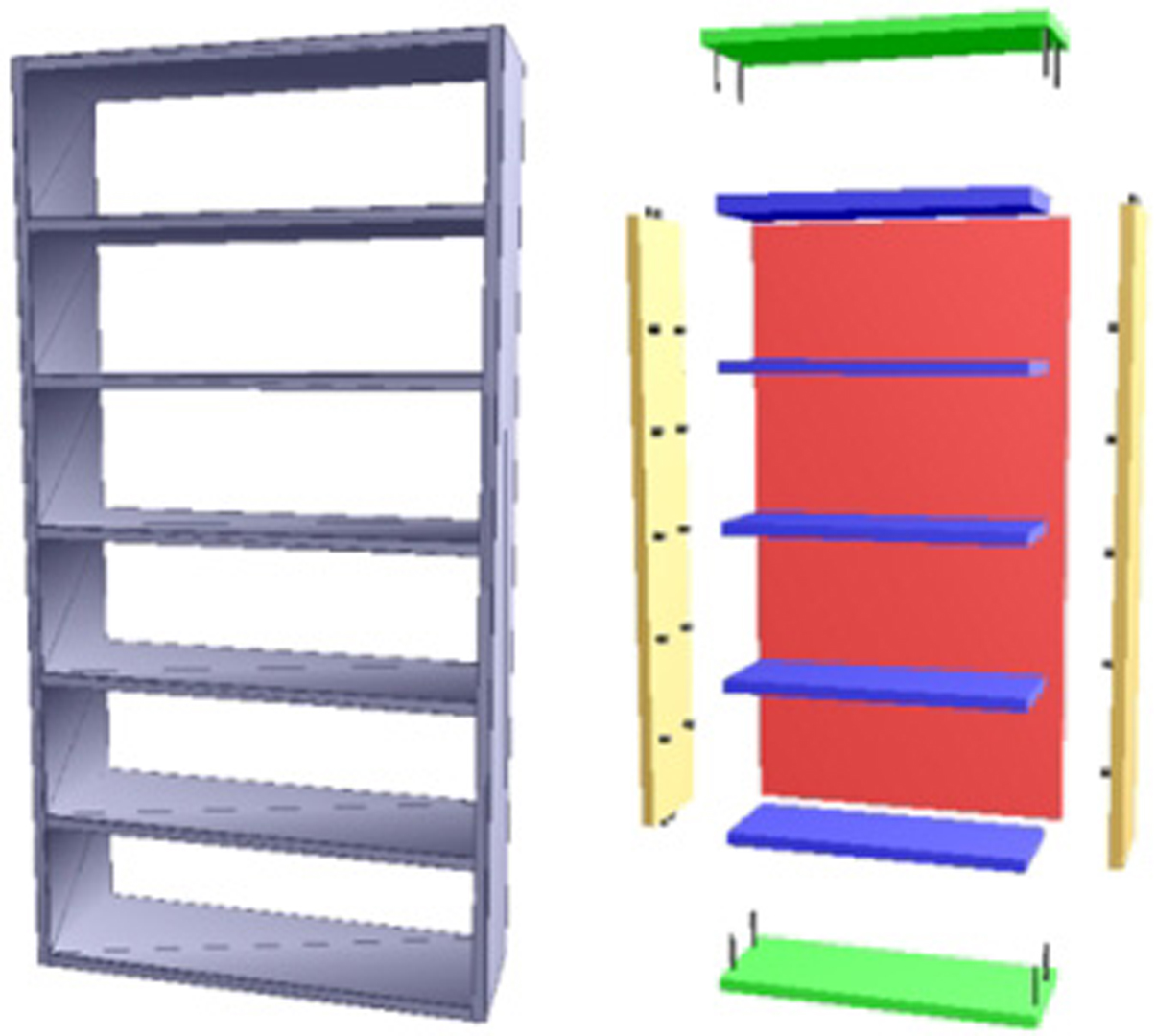“Converting 3D furniture models to fabricatable parts and connectors” by Lau, Ohgawara, Mitani and Igarashi
Conference:
Type(s):
Title:
- Converting 3D furniture models to fabricatable parts and connectors
Presenter(s)/Author(s):
Abstract:
Although there is an abundance of 3D models available, most of them exist only in virtual simulation and are not immediately usable as physical objects in the real world. We solve the problem of taking as input a 3D model of a man-made object, and automatically generating the parts and connectors needed to build the corresponding physical object. We focus on furniture models, and we define formal grammars for IKEA cabinets and tables. We perform lexical analysis to identify the primitive parts of the 3D model. Structural analysis then gives structural information to these parts, and generates the connectors (i.e. nails, screws) needed to attach the parts together. We demonstrate our approach with arbitrary 3D models of cabinets and tables available online.
References:
1. Agrawala, M., Phan, D., Heiser, J., Haymaker, J., Klingner, J., Hanrahan, P., and Tversky, B. 2003. Designing effective step-by-step assembly instructions. ACM Transactions on Graphics 22, 3, 828–837. Google ScholarDigital Library
2. Attene, M., Falcidieno, B., and Spagnuolo, M. 2006. Hierarchical mesh segmentation based on fitting primitives. Visual Computer 22 (March), 181–193. Google ScholarDigital Library
3. Bokeloh, M., Wand, M., and Seidel, H.-P. 2010. A connection between partial symmetry and inverse procedural modeling. ACM Transactions on Graphics 29, 4, 104. Google ScholarDigital Library
4. Chen, X., Golovinskiy, A., and Funkhouser, T. 2009. A benchmark for 3D mesh segmentation. ACM Transactions on Graphics 28, 3, 73. Google ScholarDigital Library
5. Fu, H., Cohen-Or, D., Dror, G., and Sheffer, A. 2008. Upright orientation of man-made objects. ACM Transactions on Graphics 27, 3, 42. Google ScholarDigital Library
6. Golovinskiy, A., and Funkhouser, T. 2008. Randomized cuts for 3D mesh analysis. ACM Transactions on Graphics 27, 5, 145. Google ScholarDigital Library
7. Gross, M. 2007. Now more than ever: computational thinking and a science of design. Japan Society for the Science of Design 16, 2, 50–54.Google Scholar
8. Igarashi, T., Matsuoka, S., and Tanaka, H. 1999. Teddy: a sketching interface for 3d freeform design. ACM SIGGRAPH, 409–416. Google Scholar
9. Katz, S., Leifman, G., and Tal, A. 2005. Mesh segmentation using feature point and core extraction. The Visual Computer (Pacific Graphics) 21, 649–658.Google ScholarCross Ref
10. Lai, Y.-K., Hu, S.-M., Martin, R. R., and Rosin, P. L. 2009. Rapid and effective segmentation of 3d models using random walks. Computer Aided Geometric Design 26 (Aug.), 665–679. Google ScholarDigital Library
11. Lai, Y.-K., Kobbelt, L., and Hu, S.-M. 2010. Feature aligned quad dominant remeshing using iterative local updates. Computer Aided Design 42 (Feb.), 109–117. Google ScholarDigital Library
12. Landay, J. 2009. Design tools for the rest of us. Communications of the ACM 52, 12, 80. Google ScholarDigital Library
13. Li, W., Agrawala, M., Curless, B., and Salesin, D. 2008. Automated generation of interactive 3d exploded view diagrams. ACM Transactions on Graphics 27, 3, 101. Google ScholarDigital Library
14. Lorensen, W. E., and Cline, H. E. 1987. Marching cubes: A high resolution 3d surface construction algorithm. ACM SIGGRAPH, 163–169. Google Scholar
15. Manning, C., and Schutze, H. 1999. Foundations of Statistical Natural Language Processing. MIT Press. Google Scholar
16. Merrell, P., and Manocha, D. 2008. Continuous model synthesis. ACM Transactions on Graphics 27, 5, 158. Google ScholarDigital Library
17. Mori, Y., and Igarashi, T. 2007. Plushie: an interactive design system for plush toys. ACM Transactions on Graphics 26, 3, 45. Google ScholarDigital Library
18. Müller, P., Wonka, P., Haegler, S., Ulmer, A., and Van Gool, L. 2006. Procedural modeling of buildings. ACM Transactions on Graphics 25, 3, 614–623. Google ScholarDigital Library
19. Nan, L., Sharf, A., Zhang, H., Cohen-Or, D., and Chen, B. 2010. Smartboxes for interactive urban reconstruction. ACM Transactions on Graphics 29, 4, 93. Google ScholarDigital Library
20. Oh, Y., Johnson, G., Gross, M. D., and Do, E. Y.-L. 2006. The designosaur and the furniture factory: simple software for fast fabrication. International Conference on Design Computing and Cognition, 123–140.Google Scholar
21. Parish, Y. I. H., and Müller, P. 2001. Procedural modeling of cities. ACM SIGGRAPH, 301–308. Google Scholar
22. Prusinkiewicz, P., and Lindenmayer, A. 1991. The Algorithmic Beauty of Plants. Springer Verlag. Google Scholar
23. Saul, G., Lau, M., Mitani, J., and Igarashi, T. 2011. SketchChair: An all-in-one chair design system for end-users. International Conference on Tangible, Embedded and Embodied Interaction (TEI), 73–80. Google Scholar
24. Shapira, L., Shamir, A., and Cohen-Or, D. 2008. Consistent mesh partitioning and skeletonisation using the shape diameter function. Visual Computer 24 (March), 249–259. Google ScholarDigital Library
25. Shilane, P., Min, P., Kazhdan, M., and Funkhouser, T. 2004. The Princeton Shape Benchmark. Shape Modeling International, 167–178. Google Scholar
26. Shlafman, S., Tal, A., and Katz, S. 2002. Metamorphosis of polyhedral surfaces using decomposition. Computer Graphics Forum, 219–228.Google Scholar
27. Stiny, G. 1980. Introduction to shape and shape grammars. Environment and Planning B 7, 343–361.Google ScholarCross Ref
28. Whiting, E., Ochsendorf, J., and Durand, F. 2009. Procedural modeling of structurally-sound masonry buildings. ACM Transactions on Graphics 28, 5, 112. Google ScholarDigital Library
29. Wonka, P., Wimmer, M., Sillion, F., and Ribarsky, W. 2003. Instant architecture. ACM Transactions on Graphics 22, 3, 669–677. Google ScholarDigital Library
30. Xu, W., Wang, J., Yin, K., Zhou, K., van de Panne, M., Chen, F., and Guo, B. 2009. Joint-aware manipulation of deformable models. ACM Transactions on Graphics 28, 3, 35. Google ScholarDigital Library
31. Xu, K., Li, H., Zhang, H., Cohen-Or, D., Xiong, Y., and Cheng, Z. 2010. Style-content separation by anisotropic part scales. ACM Transactions on Graphics 29, 5, 184. Google ScholarDigital Library




